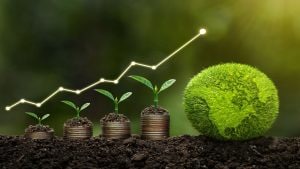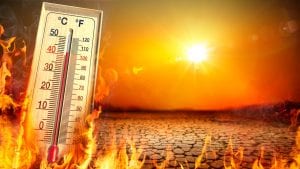Climate Clock Podcast Ep 2: Saher Bhamla explains how to master zero waste living

KV Prasad Jun 13, 2022, 06:35 AM IST (Published)
 Listen to the Article (6 Minutes)
Listen to the Article (6 Minutes)
Summary
In the second episode of The Climate Clock Podcast, CNBCTV18’s Sonal Bhutra speaks to environmentalist Saher Bhamla and Director at Bhamla Foundation, to understand the world of sustainable living and provide a practical guide on how individuals can lead a zero-waste life.
–
In a world increasingly aware of environmental issues, living a zero-waste life has emerged as a powerful way to reduce our ecological footprint and contribute to a healthier planet. In the second episode of The Climate Clock Podcast, CNBCTV18’s Sonal Bhutra speaks to environmentalist Saher Bhamla, Director at Bhamla Foundation, to understand the world of sustainable living and provide a practical guide on how individuals can lead a zero-waste life.
Unedited excerpts from the podcast:
Sonal Bhutra: This is the second edition of Climate Clock podcast and we have a very special guest with us, Saher Bhamla. Saher Bhamla has been towards working towards environment since the age of 15. She started with a beach cleanup followed by many other events for the environment.
She started engaging in more activities with the Bhamla Foundation, which is founded by her father Asif Bhamla. She’s also associated with the UNEP and has started the youth wing of the Bhamla Foundation, which is called One Earth Network. Here they are building a community of youth that participates and comes up with solutions towards a sustainable future and have 15,000 young eco champs and volunteers spread across India.
But what caught my eye is that you started working towards climate change when you were 15. That’s really young, what led to this, was it something that you saw around? Was it taught to you in the school, tell us more?
Bhamla: I have been born and brought up in Mumbai. Mumbaikar’s are extremely close to the ocean, we love the waves, it gives us a special kind of joy and peace. I was in Bandra and Carter Road was just like one minute away from my house, I’ve spent my entire childhood going to the park and then later on we started working out and walking and all of that. When I was 15, that was when I selected environmental science as a subject in my school. So I started realising that these are the issues that the planet is facing. It was a conversation that happened every day in my class, because we had one class every day of environment science. Then I would go to Carter Road and I would see this unsettling thing – our mangroves were entangled in plastic, it was the worst thing I would see. And I hated it. I can’t express how much of heart ache I got seeing that because our ecosystem is being treated like a junkyard and it is us humans who did it. So the anger was there. I would come back home and I would think what should I do? Then again, the next day I would go for a walk I would get angry and I would come back home and think what should I do?
Then I was like, someone has to start it and if I don’t do it, who’s going to do it. So it started off with a beach and mangrove cleanup because mangroves are the root of the ocean. If that is not protected, then our city would have so many floods. So that’s how the journey started.
Let me tell you one thing, that decision at the age of 15 I made to do a beach cleanup is the most empowering thing I’ve ever done. It’s the strongest thing I’ve ever done. If you ever tell me that tell me one thing that gives you happiness, tell me one thing that makes you feel empowered, it is that one decision, because I also had school, I had to meet my academic responsibilities as well. So there were two things – the focus was not only education, the focus was also to bring the change, and both took their time.
Sonal Bhutra: With One Earth Network and Bhamla Foundation, what are some of the climate projects that you’re working on? And did you get a push back when you said I want to go ahead and clean mangroves, what was your initial experience like when you just decided one day that I have to do this? Did people come to you and support you in that cause?
Bhamla: There were a lot of people while I was doing this and even now they think why am I doing this? Do I not have anything else to do? They don’t realize that I love my country and I want to do this.
I didn’t really have a lot of push back. No one would stop you from doing something.
Sonal Bhutra: Did they support you? Did they come and join you?
Bhamla: Yes, I did get a lot of support. Like you mentioned today there are 13,000 volunteers that are there in the foundation. That is itself a lot of support for me. When you’re doing a beach cleanup – and that was when I was 15 – I thought I will do four to five cleanups and it’s going to be sorted. It was just very immature at that time. I didn’t even know how to clean the beach. Now if you clean the beach there are so many technicalities, when you’re removing your trash, you’re supposed to remove the sand, you have to be very careful with the plants and the mangroves, you can’t just break them. It is our ecosystem.
We have 8.7 million species on our planet, we have to coexist with them. What we humans think is that this is only our planet, we have all the rights to it, but that is not the case. It is a planet for a lot more plants and animals that we don’t realize.
I feel I want to bring behavioural change amongst people. Doing a beach cleanup is there, I can get schools now, there are so many people who want to volunteer. It used to be an issue when initially it started, but now people have started becoming aware.
If I just put a post on Instagram, just one poster on Instagram with a form, there itself I have 200 registrations for my general cleanups. But behavioural change is something that is extremely important because if we do not change our lifestyle, if we do not change our habits, then there’s no point.
Also read: How CEO of Recircle Rahul Nainani makes a living of waste management
Sonal Bhutra: So you speak about that change and before I also talk to you about all the other things other than beach cleanups that you’ve been involved in, you work with the various people, different strata of the societies as well be it the underprivileged side, be it people of the higher levels, do you see a change in that behavior as well in different segments of the society, that one segment is more aware about it, the other doesn’t care, or vice versa, for that matter?
Bhamla: The low income groups have their own challenges. They themselves are struggling to meet ends in a city like Bombay, but 80 percent of Bombay, I think, is slum. So that is our focus. So when it comes to the low income group of society, there is just a little bit more counseling that is needed. We have to understand them. One thing I’ve realized is that they do not have any waste management. And if you don’t have waste management, all of it is going to end up in the ocean or in the landfill. And this issue needs to be addressed, because we need to be zero waste as a city. And as a country overall, it’s a huge country, and Mumbai, itself is like four European countries. So it’s not easy for even the authorized people to do a lot of things. But we as humans can do it for the betterment of the society and what we do is to put our message out there to make the masses understand the issue for them to realize the problem. We come up with these musical anthems. Because when you talk about environment, the first thing that comes to your mind is it’s a lecture. It’s a class, it’s a conference where there are people sitting writing down a few things, have various files and we don’t know what’s happening after that – they have so many plants that is there. And we all know what has to be done. The question is, who’s going to come and do it?
So we started curating these musical anthems on various themes. The United Nations Environment Program comes up with a theme around the World Environment Day every year, and we work on it throughout the year. So like, this year, it was beat plastic pollution, last year, it was only one earth, before that it was ecosystem restoration. And before that, it was air pollution. And again, before that, five years back, it was plastic pollution when India was a global host. So you see plastic is a huge issue. That’s why even the UN came up with the theme again in five years, because that one piece of straw that we use for 10 minutes remains in the environment for 500 years. It turns into microplastic, it is in the ocean, fishes and sea animals think it’s food, they end up eating it and then we eat those fishes and the plastic ends up in our blood.
Sonal Bhutra: So that’s a problem. That’s like it’s coming back to you. Basically, what you’re throwing in the ocean is coming to you.
Bhamla: It’s karma.
Sonal Bhutra: As you said, behavioral change is the first step. Waste Management is the first step.
Bhamla: And then I started to do realize that everyone is not going to listen to me. If my target audience was the masses, it was not only the classes and I’m not an influencer, I’m just doing my bit. And tier one, tier two, tier three, they really enjoy songs and dance and they really enjoy watching our actors. They idolize them, a lot of them. Because if Sachin Tendulkar says something, they tend to follow it. Kapil Sharma went plastic-free on his show, and he had just tweeted about it, we had propagated that because we are known to so many of them. He went plastic free, and he just put out a tweet that I’m going plastic free, I urge all my fans also to start making conscious changes, and they would start talking about it. Then we would get emails, on Twitter – social media is so empowering at times, it really does connect us to the world. So people would send us messages and emails that if Kapil Sharma is doing this, even I’ve removed plastic from a house. I sweat it has happened. So I don’t know the impact these actors have, the influence they have over people is massive, their influence is influencing in a positive way now. So that’s how Alia Bhatt, Bhumi Pednekar all of them are part of the campaigns.
Sonal Bhutra: That’s amazing. And hopefully, the positive message is going across. And that’s what really matters at the end of the day. So you said you work with the Bhmala Foundation since the age you were 15. And you’ve stepped up there and also started a separate baby company or a separate outfit of that that’s called One Earth Network.
Bhamla: It is a youth wing.
Sonal Bhutra: What empowered you to do that separately? What are some of the learnings that you had from your father? Because he’s been doing that for a long time?
Bhamla: Yes. So I’ve always wanted to build something for myself. I never wanted to be answerable to anyone about the things I want to do in life. And it’s not that I’m still working in the foundation as well. But we have 13,000 young people working not only in Bombay, it is across India, it is a pan-India Foundation, we have a base in Rajasthan, we have a chapter in Kashmir, where I led the Dal Lake cleanup for one week, then we have a section in Delhi. So there are so many places. Kerala is something that we are really keen on working on. So why not just give them – I wanted to give them an identity. One Earth Network is something that you’re a part of, and I wanted these young people – they wanted to do it, I didn’t want to do it, it was just a lot of conversations that we had and then we came up that let’s do like a One Earth Network where young people go out there, see the problem that is happening, find the solutions, and then we implement it together. Because the foundation does have the resources to fix a few issues that are there.
Also read: Climate change, veganism, wardrobe detox and much more with Aakash Ranison
Sonal Bhutra: So One Earth Network is a separate organization, which is focusing on environment cleanups or beach cleanups or maybe generally fight against climate change. As you said, if the youth wing of Bhamla Foundation. People usually don’t listen to youngsters, so there would have been some challenges for sure that you yourself faced as a young activist against climate change. Tell us something about that. And also, I wanted to understand what is the message that you would like to give to your peers, to the young generation when it comes to this fight against climate change?
Bhamla: I keep on talking about a sustainable lifestyle, a zero-waste lifestyle because it is very important, otherwise, we all will be drowning in garbage if we don’t shift our lifestyle into better options. But a lot of people, I have realized, when I’m talking to are volunteers, sometimes we end up meeting their parents and we make conversation because even I’m trying to understand what people think about climate change. So I can work in that direction that would help everyone. So what they think is climate change and doing things being environmentally friendly is extreme. It’s either left or right. So the ones who are very conscious are extremely conscious, which is amazing. It’s something I want to do, but the ones who are not conscious think that it is not possible. They think it’s very tough. They think that changing your attitude might not – I don’t know there is something going on in their head. Climate change is nothing. They think how we would do it because plastic and disposables are available to us in such an easy manner that they just end up buying it and now people have started living a life of convenience. Earlier if you see 50 years back, that was not the scenario, not only not 50 years even if you talk about 20 years, our homes had matkas, we never had a plastic bottle ever. Did you ever have a plastic bottle?
Sonal Bhutra: I still don’t use one.
Bhamla: We used to shop local. Everything that comes in a packaging does have an impact on the environment. And when we have the option to shop local still I don’t know why people – it’s like I mentioned behavioral change, starting to realize, starting to co-exist in with a planet is something that people should come to terms with.
Sonal Bhutra: And that is a message that everyone – because I think as you said, it’s convenience at the end of the day, which everyone’s looking at. You can quickly get a water bottle, let’s not carry one. You can quickly just get packaged food, let’s not get something from the local vendours.
Bhamla: I have gone to houses where they have disposable plates. They’re using it on daily basis. They don’t have reusable plates. They have these disposable plates. They eat once and then they throw it. I just went to see the garbage in their dustbins, it was massive. And food wastage is also the second biggest reason for global warming. And sometimes even I tend to waste food, which is not right. Our fridges are filled with so much of food. We stack things for one month. And earlier, it used to be only for two-three days, it was never four months, half of it gets expired and thrown away.
Sonal Bhutra: That’s true. After one month, and you’re like, oh, we can’t use it anymore. That happens very often.
Bhamla: I know. It’s in my own house. My uncle, my dad’s brother buys four-four bottles of ketchup. I don’t know why he’s doing that. I go to his house and I’m seeing what’s this. He stacks rice for three months in one go. That’s not right.
Sonal Bhutra: So when you said there are extreme opinions as well, do you believe in the activist side where people are going ahead throwing oil on paintings to prove a point?
Bhamla: Absolutely not. I understand it is anger. But if you’re angry, you must go and do something for the environment. They uses shock as a way of getting the message out there. But this is not right and I do not support it. And how does it make a difference? You tell me. Spilling oil on a painting, did it actually do anything for climate change? The person just came in news for the next two weeks. Also, I do not understand if you really love this earth, you must do something for it. By spilling oil on a painting, you’re doing absolutely nothing. And it is very wrong. Negative activism will not take you anywhere. You asked me that do you face any challenges. Coming to this, the most powerful tool that anyone can use is love. And when you want people to listen to you, you have to give them love. I can’t give them anything else. But the least I can give is love. And this is only hate what they’re doing.
Sonal Bhutra: Be in the system to go ahead with the system and change the behavioral aspect that you are talking about.
Bhamla: Yes, absolutely.
Sonal Bhutra: I do take that point and that makes things easier for the society to come together.
Bhamla: It divides the population. This is extreme, I don’t understand. I was very upset when I keep on seeing all this. It happens very often now. Because it gets covered on social media and it just gets popular. But in terms of change, there is no change that has happened.
Sonal Bhutra: We are glad the change that you are bringing about so when I was asking you apart from beach cleanups, you have gone from Mumbai to Kashmir as well – the Dal Lake cleanup.
Bhamla: I love Kashmir, so I had to do something.
Sonal Bhutra: So, what is next on your to do list now. Is there something different that you are planning and what are the other aspects that you want to cover or have covered?
Bhamla: We do have a lot of plans normally we make a plan in December only for the next year that is happening. So, building green spaces in the city. Starting from the city is something I am very keen on because we have so much of pollution, air pollution, plastic pollution, we are breathing the worst air possible. It is so toxic, and it is not even an option to breathe better. So green space is something that I am extremely keen on. We have already started working with a lot of schools and colleges on this because they have their parks and they have their grounds, and that is where we can build like an urban forest. And the good thing is the students start getting involved because once I build it then we obviously keep a check on it, but we request the students, the ones who study biology and sciences, basically to understand it, and to do the needful for the forests, and then we also have a campaign called Ecobiz that is involving the entire business community because like you mentioned, we work with a lot of people who have an influence, the pioneers and for example from construction, the amount of waste that construction is doing all of it is thrown in a mangroves, the amount of debris that is there, it is horrible and right now our city is literally under construction. So, the pioneers from the field of construction, education, even medical all of them come together, there is a plan of action that they themselves give it to us. It’s not that the business does not want to work for the environment, with whatever my experiences, they all have been very pro-change and if you see now there is a 360-degree turn. It used to be companies that used to pollute the earlier, but now it is us individuals who are doing it more than them. I mean, they still do it. It’s not that they are not doing it. But we individuals have crossed everything.
Sonal Bhutra: That is not a good statistic to talk about. But of course, we can work on it. So, as you pointed out that you are planning things across the city in terms of green spaces. Space is a problem in Mumbai. We all know that. So, in that case, apart from Mumbai, whatever plans you have in place, have you had conversations with the government something that you would want to tell them because come December what we saw last year, the problem with that crazy smog that should not be happening, any word with the Brihanmumbai Municipal Corporation (BMC- governing civic body of Mumbai), or the government, generally, policymakers?
Bhamla: All our campaigns, most of them is with the Municipal Corporation of Greater Mumbai (MCGM) or BMC (as popularly known in the city); a lot of them is with the Ministry of Environment, forest and climate change, and they always do support good work. And it is not only mine, if you see any other person who is bringing a change. There are so many youngsters who are doing beach cleanups, there are so many people who are doing their bit. And it’s never that the BMC or local authorities have not supported. It might be a little slow. It might. I have not felt it, but on behalf of others, but it is never ignored. For example, I used to always have this question that I am cleaning the beach. The waste is going in the landfill after it’s been cleaned. So, I wanted to change that. Landfill is better than the ocean because the waste in the ocean is killer. Sea animals eat it, and they end up dying on the spot. It is killer, it is toxic, it is the worst thing possible you have to get the waste out of the ocean because the sea animals end up eating like I mentioned, and plastic is there in our blood, in the air we breathe, every single place. So, for a very long time the waste was collected from the beach, and it used to go on the landfill. The BMC would collect it, there is a segregation that they have in the outskirts, but not everything is segregated and even when it comes to plastic segregation, only the recycled plastic can be recycled. There are different types of plastics. I recently saw somewhere that your chocolate wrappers are not recycled, those toffies we eat – that is not recycled, but food choices are not something I can’t comment on, but what we can do is buy those bigger slabs of chocolates. Coming back to BMC, it is there in the landfill. It is not harmful to any living thing but there has to be an end to it. So, I wanted to start a recycling plant, and we have started it luckily. So, it required a lot of help from these policymakers, from the government, it is not an easy thing. So, when we started it, everyone really did support us. It became a lot easier because we had them on board with us. You have to work hand in hand with everyone. A lot of people like you asked me that, what is the challenge in your activism that you face? The thing is that individual citizens think that it is not our job, we are paying taxes, it is the government’s job to clean it. But climate does not work like that, environment does not work like that. Even if the government alone does it, it needs the involvement of citizens, it needs the involvement of corporates, if we all come together, it is a collaborative effort that has to be made. You can’t be like I am paying taxes and it is done. Where all sorts of waste is being recycled from your dry waste, wet waste, e-waste. And it is my focus for, I don’t know the next how many years, but I do wish to segregate all the waste. Waste segregation is the most important part of recycling. If your waste is not segregated, you cannot recycle it. And it is the most tedious part because it requires a lot of manpower as well, and there as well I also like to generate employment. There are so many ragpickers who are into wrong things because they also have their own struggles in life. So, giving them employment was something that made me also feel very happy about that I am helping someone in a way he has a job. So, segregation takes hours and hours. We have so much of waste coming from various buildings of Bandra then from the cleanups that we do regularly.
Sonal Bhutra: You basically recycle or collect at least 15 tonne of waste is what I read.
Bhamla: Yes. I am guessing it is a little bit more now. That was not updated.
Sonal Bhutra: But that would be over how many years? Just an approximate timeframe.
Bhamla: It’s been about 8-10 years.
Sonal Bhutra: And that is just a particular locality that you are talking about. So maybe over the city, it would be crazy.
Bhamla: Bandra itself is so challenging. Like it told you, the city is so big, that Bandra only is so challenging, but we do work a lot in the rural areas of Maharashtra as well, in the outskirts and there is a lot that is happening. The other thing that is my focus is, this was an initiative not campaign done by my father, but I take great inspiration from him in this thing because he saw the vision of converting waste into energy a few years back, and if you see at Pali Hill, we have a biogas plant. So, all the waste of Pali Hill, whichever is collected goes to that plant and waste is converted into energy and the streetlights, which earlier the bill used to come for Rs 10-12 lakh a year at Pali Hill only, now it is free of cost because the streetlights are generated from that. The second plant is still in the plan at Navi Mumbai.
Sonal Bhutra: However, I have to ask you before I let you go, because this has been such an interesting conversation. You have been working you said on this project or in this field for the last many years since you were 15. Any one incident that maybe shocked you or maybe surprised you, any conversation with someone when you were on your cleanup drives, something that you learn something from or you would like people to know that okay, this is not something that should be done. Either way, it’s something that is in your mind.
Bhamla: There are many-many incidents. If you ask of one, it just gets a little tough. But what I like to see is there is a very old lady, I think she is 70. She does not come regularly. But she makes it a point that at least once in two months she is coming for a cleanup and when I see her having a blast during the cleanup, it is just something inspirational. I like seeing her every now and then. And there are young students who come up with their own ideas and they come, and they speak to us and that is when I enjoy because I feel they are being involved in it. So, the main reason for beach cleanups now; earlier when I was 15, it was for my own cheer angle that I am going to clean it. But now, the reason why we involve these students is because we want them to see the problem. When you see the issue, you start to realize that – look what have we done. If I wouldn’t have had seen, if I didn’t go for my walks at Carter Road, I wouldn’t have seen it and maybe I would have had never started doing it. So, when you see it, you automatically get heartache, any normal person who has a heart will feel bad because it is very bad, the site is very bad, it’s still bad because the ocean keeps on going on the waist.
Sonal Bhutra: And we get that when it rains, we get it back.
Bhamla: It is very bad. Our Prime Minister himself cleans the beach with his own hands. It is a subtle message that he wanted to put across that if I am cleaning it, if me being the Prime Minister I am going for a beach cleanup — he could have gotten so many people to clean it and he would be standing there — that could have been done, and that is how other countries have been doing, like if the Prime Minister want to show a message on climate change. But he chose to do it with his own hands and even he speaks about environment from the Red Fort. It is not a topic that the Prime Minister normally used to talk about if you have seen in the past, or even if you see other Prime Ministers, not from the Red Fort. They don’t talk about environment; they don’t talk about toilets. But we can see that even he loves it.
Sonal Bhutra: It is a mainstream conversation now and that is what the idea is that we want to make this conversation a daily conversation, a dinner table conversation so that we relate with it and we try and understand how our daily habits are impacting the environment, just that you said, so many ketchup bottles, using disposables at your home.
Bhamla: When you go to McDonald’s — this is not in America I recently went, I saw there was some machine where you remove the ketchup from. But if you go here, even at a McDonald’s, they are giving you sachets; there are salt sachets, there are sugar sachets, there is just so much of packaging that is in and around your daily life. If you go to a hotel now, and people never carry their shampoos; people who I know, people from my own family at times do this, like not from my immediate family. So, when you go to a hotel, we end up using toothbrushes, shampoos, look at the amount of packaging, the comb comes in packaging and in one day we must be using two-three of them. So, imagine the waste we are generating as humans and it is not difficult to carry your own stuff to wherever you are traveling, but it is the laziness and convenience.
Sonal Bhutra: So, we ae doing a lot of things at the back of convenience and also because a lot of them are unaware of the impact I would say of their daily habits or daily consumption patterns. So, with this conversation, I hope we have been able to at least start a debate on what is right and what is not right when we do our daily activities in terms of consumption as well.
Bhamla: I just request, like you mentioned make a checklist. Remove three things from your daily life. The top three things is your coffee mug. I am sure in Bombay a lot of people go to cafes carry your own mug. So that is where you avoid that disposable mug and it is something a lot of people consume. So, carry your own coffee mug, carry a water bottle. I really liked it that you gave me water in a glass. There are times when I feel scared to ask for water because what if they get it for me in a plastic bottle and here you got it in a glass and I was like, Thank God. And at home make a checklist that these things are not important, and I can do without it and go ahead without doing that.

Elon Musk forms several ‘X Holdings’ companies to fund potential Twitter buyout
3 Mins Read
Thursday’s filing dispelled some doubts, though Musk still has work to do. He and his advisers will spend the coming days vetting potential investors for the equity portion of his offer, according to people familiar with the matter

KV Prasad Journo follow politics, process in Parliament and US Congress. Former Congressional APSA-Fulbright Fellow










 Listen to the Article
Listen to the Article  Daily Newsletter
Daily Newsletter












